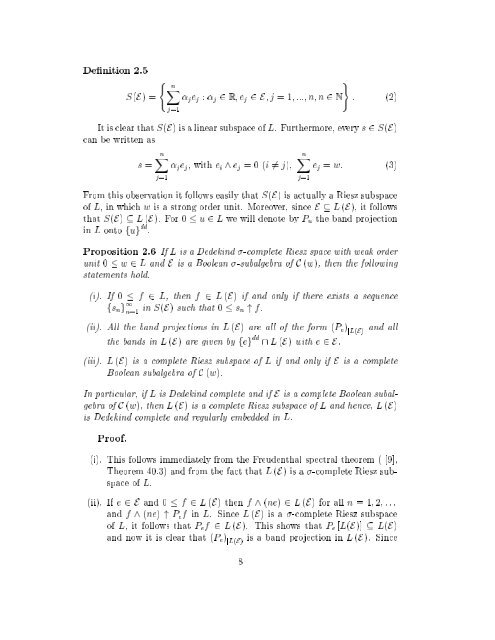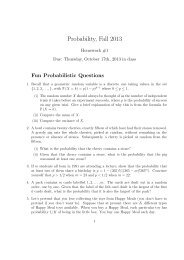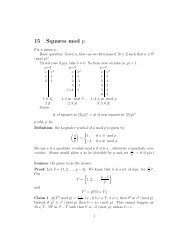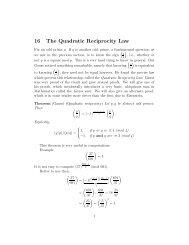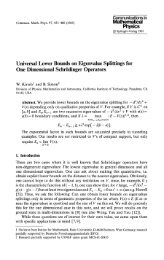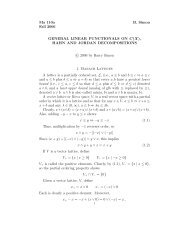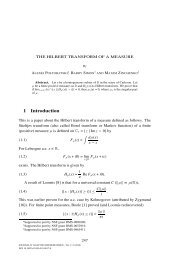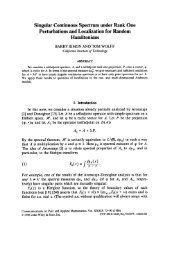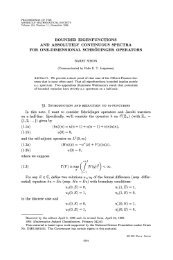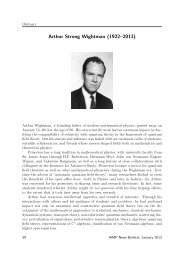Representations of positive projections 1 Introduction - Mathematics ...
Representations of positive projections 1 Introduction - Mathematics ...
Representations of positive projections 1 Introduction - Mathematics ...
Create successful ePaper yourself
Turn your PDF publications into a flip-book with our unique Google optimized e-Paper software.
De nition 2.5<br />
S(E) =<br />
( nX<br />
j=1<br />
jej : j 2 Rej 2Ej =1:::nn2 N<br />
)<br />
: (2)<br />
It is clear that S(E) is a linear subspace <strong>of</strong> L. Furthermore, every s 2 S(E)<br />
can be written as<br />
s =<br />
nX<br />
j=1<br />
jej, with ei ^ ej =0(i 6= j),<br />
nX<br />
j=1<br />
ej = w: (3)<br />
From this observation it follows easily that S(E) is actually a Riesz subspace<br />
<strong>of</strong> L, in which w is a strong order unit. Moreover, since E L (E), it follows<br />
that S(E) L (E). For 0 u 2 L we will denote by Pu the band projection<br />
in L onto fug dd .<br />
Proposition 2.6 If L is a Dedekind -complete Riesz space with weak order<br />
unit 0 w 2 L and E is a Boolean -subalgebra <strong>of</strong> C (w), then the following<br />
statements hold.<br />
(i). If 0 f 2 L, then f 2 L (E) if and only if there exists a sequence<br />
fsng 1<br />
n=1 in S(E) such that 0 sn " f.<br />
(ii). All the band <strong>projections</strong> in L (E) are all <strong>of</strong> the form (Pe) jL(E) and all<br />
the bands in L (E) are given by feg dd \ L (E) with e 2E.<br />
(iii). L (E) is a complete Riesz subspace <strong>of</strong> L if and only if E is a complete<br />
Boolean subalgebra <strong>of</strong> C (w).<br />
In particular, if L is Dedekind complete and if E is a complete Boolean subalgebra<br />
<strong>of</strong>C (w), then L (E) is a complete Riesz subspace <strong>of</strong>L and hence, L (E)<br />
is Dedekind complete and regularly embedded in L.<br />
Pro<strong>of</strong>.<br />
(i). This follows immediately from the Freudenthal spectral theorem ( [9],<br />
Theorem 40.3) and from the fact that L (E) isa -complete Riesz subspace<br />
<strong>of</strong> L.<br />
(ii). If e 2 E and 0 f 2 L (E) then f ^ (ne) 2 L (E) for all n = 1 2:::<br />
and f ^ (ne) " Pef in L. Since L (E) is a -complete Riesz subspace<br />
<strong>of</strong> L, it follows that Pef 2 L (E). This shows that Pe [L(E)] L(E)<br />
and now it is clear that (Pe) jL(E) is a band projection in L (E). Since<br />
8


